Key takeaways:
- Web accessibility enhances the digital experience for all users, creating an inclusive environment through thoughtful design elements like alt text and easy navigation.
- Prioritizing accessibility is both a moral obligation and a legal requirement, fostering a culture of understanding and compassion online.
- Common accessibility barriers include insufficient color contrast, lack of keyboard-friendly navigation, and inadequate multimedia accessibility.
- Testing with real users, particularly those with disabilities, is crucial for understanding their needs and improving design effectiveness.
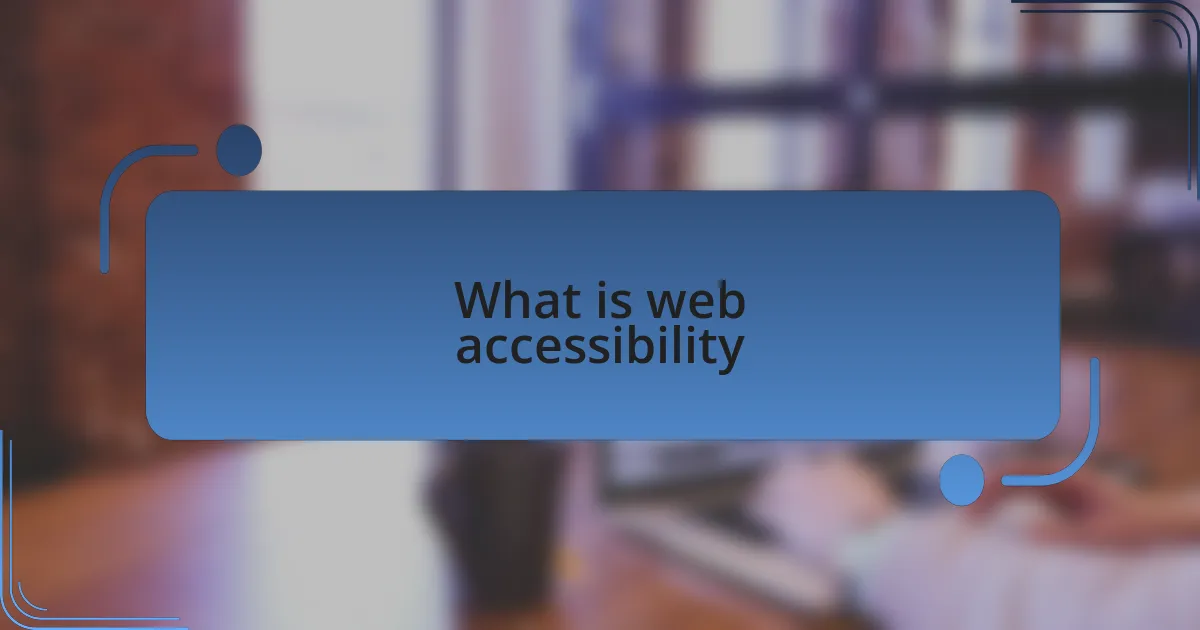
What is web accessibility
Web accessibility refers to the practice of designing websites so that people with disabilities can navigate, understand, and interact with them effectively. I remember when I first learned about this concept; it struck me that a simple design choice could significantly impact someone’s ability to access information. Have you ever considered how frustrating it can be to encounter a site that doesn’t work with screen readers or lacks proper contrast?
At its core, web accessibility means creating an inclusive digital environment. This includes considerations like alt text for images, easy navigation, and keyboard-friendly interfaces. During a project I worked on, integrating these elements not only made the site usable for everyone but also improved overall user experience, leading to higher engagement rates. Isn’t it fascinating how accessibility can actually enhance a website for all users?
Accessibility isn’t just a checkbox; it’s about empathy and understanding the diverse needs of users. I often think about the various ways people interact with technology, whether due to visual impairments or cognitive differences. Embracing web accessibility challenges us to think beyond our own experiences and to ask ourselves: how can we make the web a welcoming space for everyone?
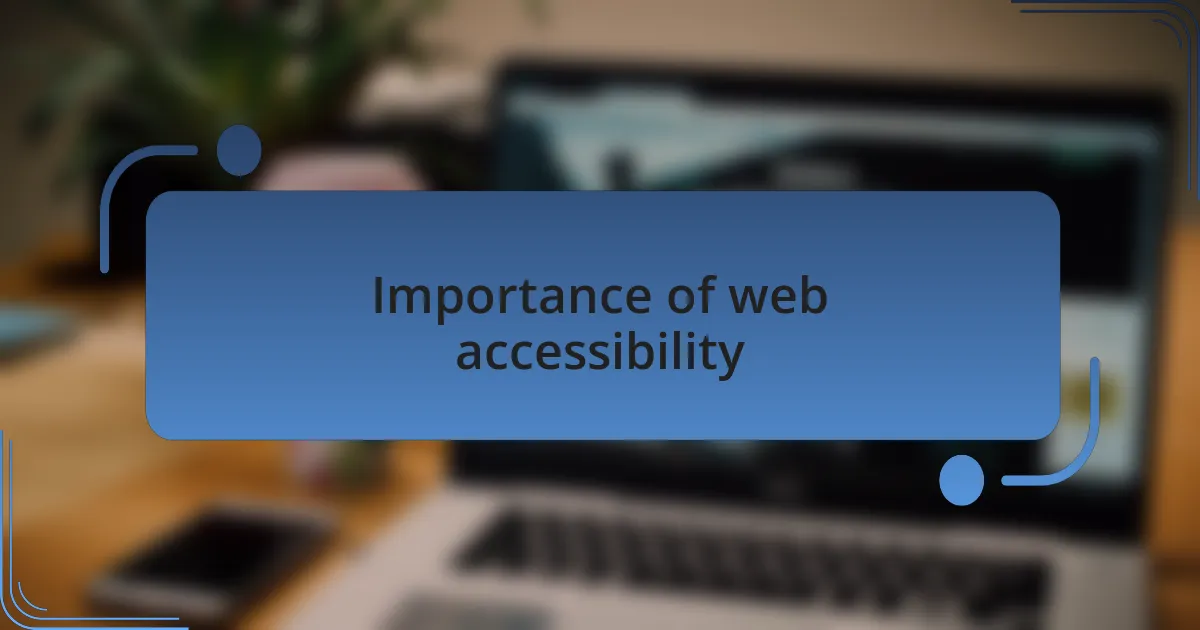
Importance of web accessibility
When I first delved into web accessibility, I was struck by how it opens doors for countless individuals who might otherwise be excluded from online interactions. Imagine needing to access critical information but facing hurdles just to reach it. This experience is not just theoretical; it’s a reality for many. Recognizing this has made me more determined to champion practices that break down these barriers.
Access to information should be universal; when a website prioritizes accessibility, it speaks to a commitment to inclusivity. I vividly recall a project where we revised the color scheme for better contrast—an adjustment that not only helped individuals with visual impairments but also made the content pop for everyone. Isn’t it incredible how such a simple change can enhance usability for all users?
Moreover, prioritizing web accessibility isn’t just a legal requirement; it’s a moral obligation. I often reflect on my interactions with diverse groups and how their unique experiences shape the way they navigate the web. Isn’t the power of the internet in making connections and sharing knowledge? By making digital spaces accessible, we nurture a culture of understanding and compassion, allowing everyone to engage fully.
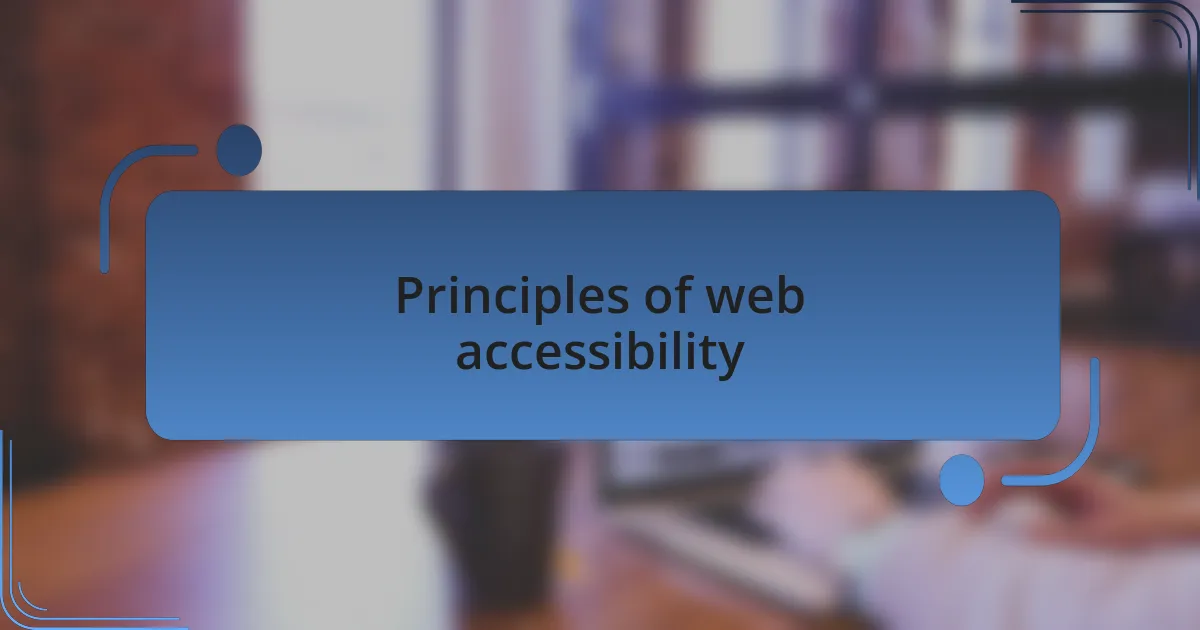
Principles of web accessibility
When exploring the principles of web accessibility, I often reflect on the importance of perceivable content. I remember working on a website redesign where we implemented alt text for images. It may seem like a small detail, but I saw firsthand how this simple adjustment allowed visually impaired users to enjoy the same experience as sighted visitors. How empowering it must feel to access a site without barriers, all because we chose to be mindful of this principle!
Another essential aspect is operable navigation. I can recall a time when I struggled to complete a task because the website’s navigation was cluttered and confusing. After realizing that many users might feel the same frustration, we streamlined menus and added keyboard shortcuts. This shift not only improved the experience for users with mobility challenges but also made navigation smoother for everyone. Isn’t it fascinating how thoughtful design can positively impact all users?
Then we have understandable content, which is vital for creating a seamless user experience. I once encountered a website filled with jargon that made me feel lost. It was a stark reminder of how clear language can bridge gaps instead of creating them. In my experience, simplifying complex terms not only benefits those with cognitive disabilities but also enhances overall comprehension for all users. Doesn’t everyone deserve clarity when they seek information online?
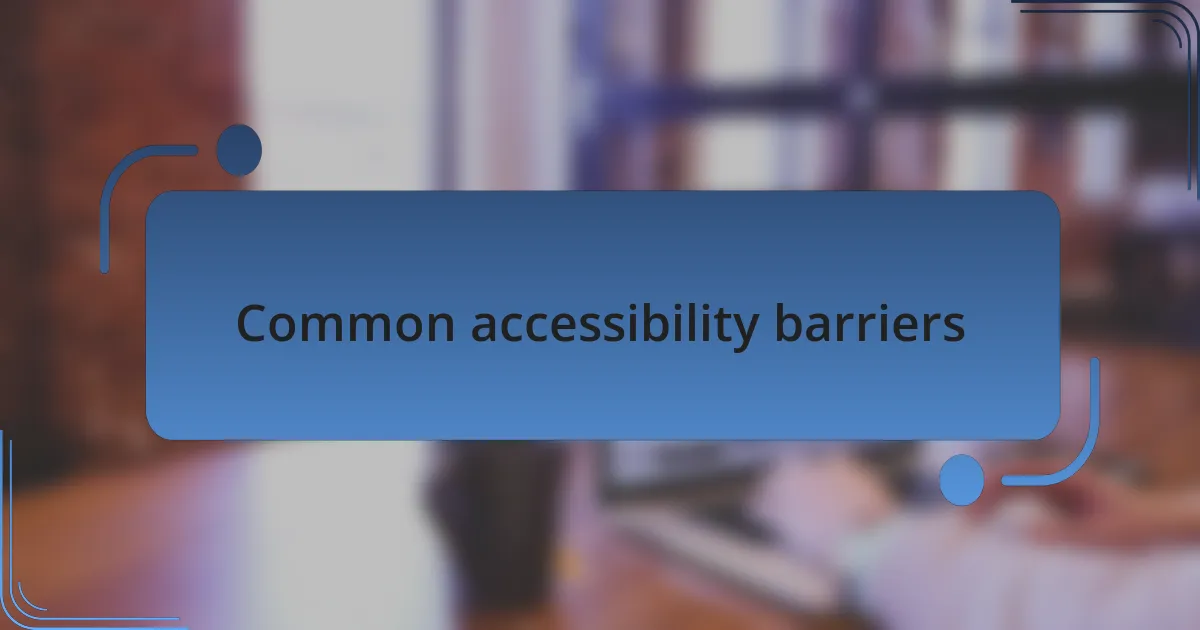
Common accessibility barriers
One common accessibility barrier I often encounter is the lack of sufficient color contrast. I vividly remember reviewing a site with light gray text on a white background, which made reading an ordeal. It struck me how easily this oversight could alienate users with visual impairments. Why should anyone struggle to read content that should be readily available to them?
Another barrier I see frequently is the absence of keyboard-friendly navigation. I once worked with a talented developer who had implemented beautiful dropdown menus, but I quickly realized that they were entirely mouse-dependent. It made me think about users who are unable to use a mouse due to disabilities. How frustrating it must be for them to be denied access to crucial information just because thoughtful design wasn’t prioritized.
I can’t overlook the importance of multimedia accessibility, particularly when it comes to videos. I once experienced the disappointment of missing out on valuable video content because there were no captions or transcripts. This clearly ties back to the idea of inclusion. Shouldn’t everyone have the opportunity to engage with important content, regardless of their hearing abilities? By embracing elements like captions and audio descriptions, we can ensure that all users feel welcomed and informed.
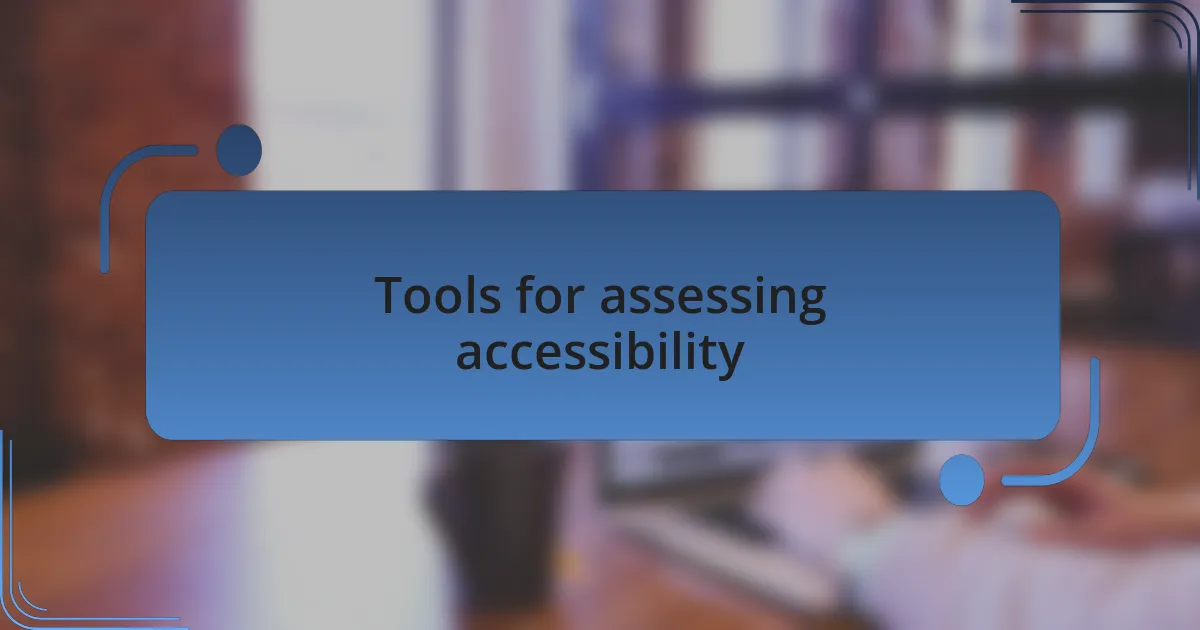
Tools for assessing accessibility
When assessing web accessibility, I’ve come to rely on various tools that serve as my digital allies. One tool that stands out is Axe, a browser extension that analyzes your web pages for accessibility issues in real time. I remember using it for the first time on a site I was redesigning; within minutes, I uncovered glaring issues I had been unaware of—issues that could easily frustrate users with disabilities.
Another favorite of mine is Wave, a comprehensive web accessibility evaluation tool. During a recent project, I used Wave to test a newly designed homepage. I was amazed by the detailed reports it provided, highlighting not just errors but also areas for improvement. It made me reflect on how essential it is to have these insights at my fingertips. Wouldn’t it be great if every designer had access to such powerful feedback before launching their sites?
Lastly, nothing beats the experience of using screen readers for personal testing. I once spent an afternoon navigating a site using VoiceOver, not only learning about the barriers firsthand but also gaining empathy for the users who depend on such technologies. It’s surprising how much I grasped about usability challenges; wouldn’t it be beneficial for every web designer to step into the shoes of their users, even if just for a moment?
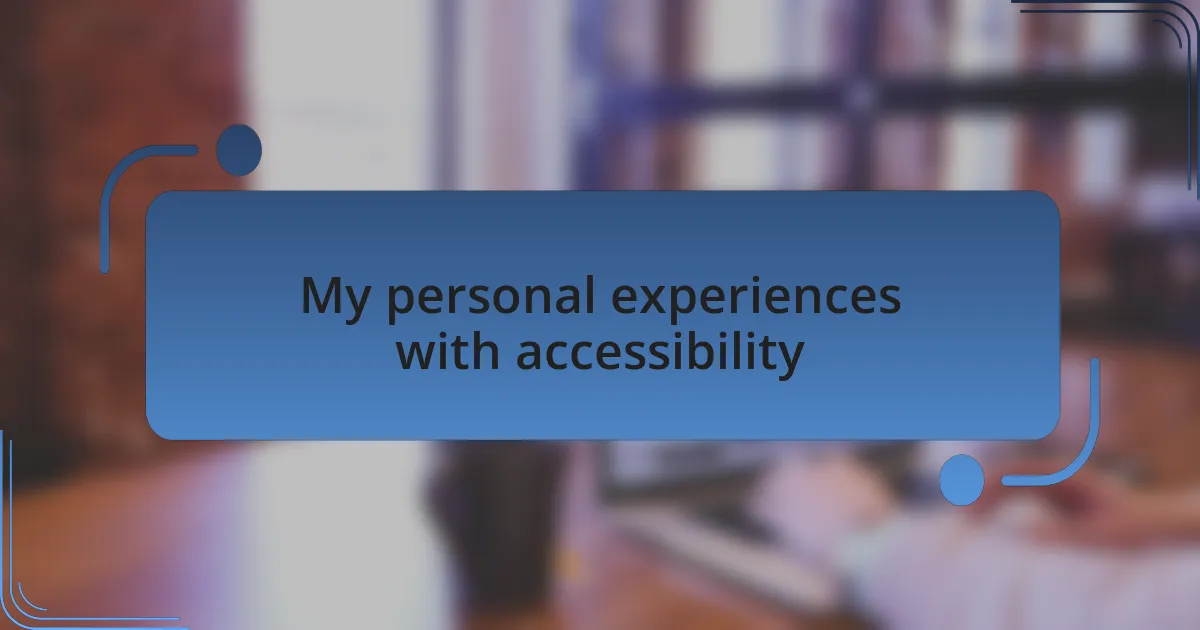
My personal experiences with accessibility
My journey with accessibility began on a project where I designed an e-commerce site. Initially, I was focused solely on aesthetics and functionality, but then I received feedback from a user who struggled to navigate it due to missing alt text on images. It hit me hard; my design decisions directly impacted someone’s ability to engage with the site. I realized then that accessibility shouldn’t be an afterthought—it must be woven into the fabric of the design process.
One memorable moment happened while I was testing a navigation menu using keyboard-only navigation. I had never considered how vital keyboard shortcuts are for users with mobility disabilities. The sheer frustration of getting stuck and feeling stranded on that site made me rethink my approach. Isn’t it fascinating how a short period of discomfort can instill a greater awareness of the diverse needs of users?
Another experience that profoundly impacted me was working with a client whose child had a visual impairment. As we discussed their needs and preferences, I saw the importance of inclusive design come to life. It was more than just a business requirement; it was personal and emotional. How could I ignore such genuine voices when creating experiences meant for everyone? This experience reinforced my commitment to embedding accessibility into every project I tackle.
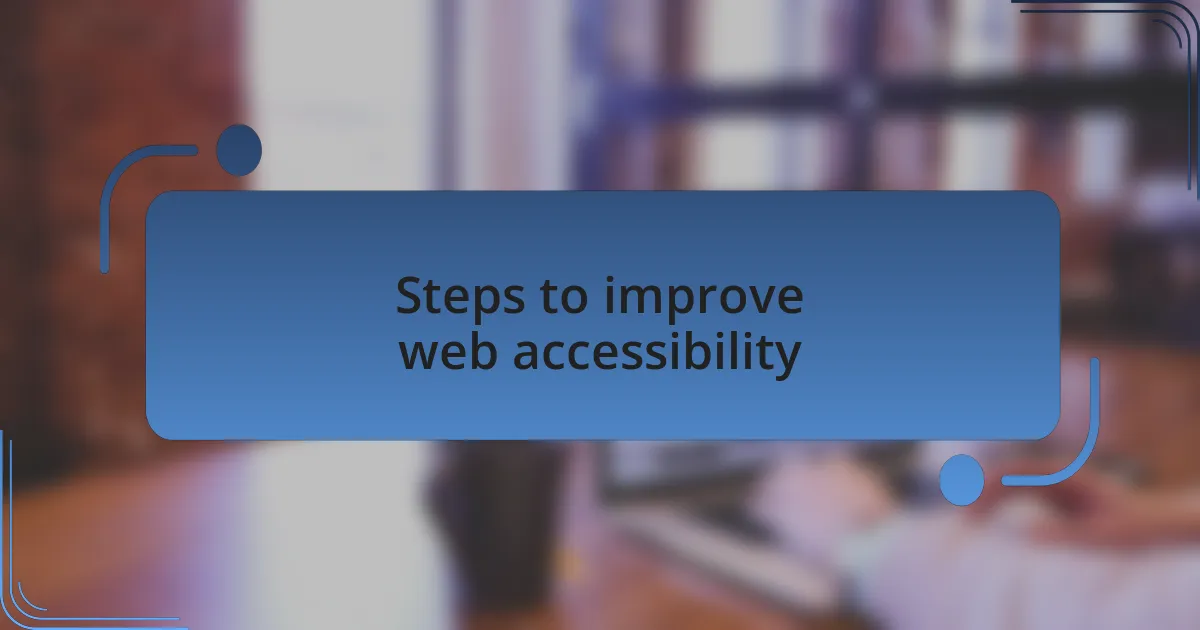
Steps to improve web accessibility
To improve web accessibility, one of the first steps I always recommend is to incorporate meaningful alt text for images. I recall a time when an image on my site was beautifully designed but had no description. A visually impaired user reached out, explaining how isolating it felt to miss out on the intent behind the imagery. This experience made me realize that what seems visual to some can be a lost opportunity to connect with others.
Next, ensuring keyboard navigability is crucial. During a project, I tested the site using only my keyboard and encountered several barriers. I could feel the frustration building with each tab that led me nowhere. It struck me that if I, as a designer, struggled, how much more challenging would it be for users who rely solely on keyboard navigation? This personal challenge propelled me to create smoother, more accessible navigation paths.
Lastly, I suggest regularly testing your site with real users, especially those with disabilities. I once organized a user testing session where participants shared their experiences directly with me. The emotional weight of their feedback was humbling; it highlighted how essential it is to listen to the voices of those you design for. Have you ever paused to truly hear what your users are saying? Their insights can guide you in making impactful changes.